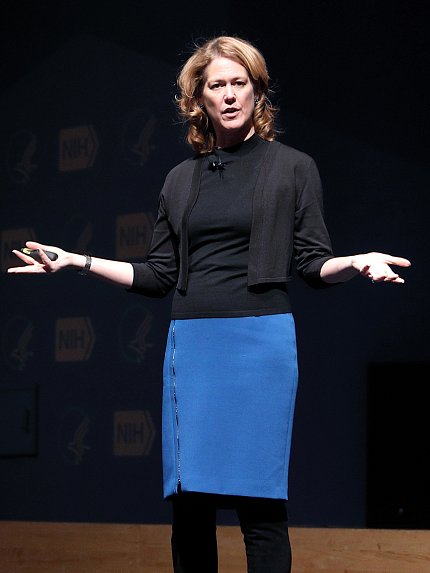Heen Discusses Art of Receiving Feedback Well

Photo: Chia-Chi Charlie Chang
A little gratitude would be nice. Instead, the draft you meticulously labored over comes back fully revised and your face turns redder than the ink on the page. It can be tough receiving negative feedback, but is some of it perhaps valuable?
“Every single day, we swim in an ocean of feedback,” said Sheila Heen during a recent interactive and witty Deputy Director for Management seminar in Masur Auditorium. “It’s our relationship with the world—how we’re impacting other people—and the world’s relationship with us.”
There’s often no shortage of feedback from bosses, colleagues, teachers, family and friends. It’s usually direct. Sometimes it’s unspoken and plenty of it is unsolicited. Other times, we want more specific feedback and aren’t sure how to request it.
“Receiving feedback is actually a distinct and critical leadership skill,” said Heen, bestselling author, Harvard Law School lecturer and founder and CEO of Triad Consulting Group. “If you get better at it, you can actually learn even from the poor givers in your life.”
Getting negative feedback can be difficult to digest because we want to learn, yet we also want to feel accepted and respected the way we are now. We need to constantly manage these two conflicting needs. One way to do so, said Heen, is to convey to others the kinds of feedback we need at any given time.
All three kinds of feedback—appreciation, coaching and evaluation—help us learn and grow over time. “Appreciation is a big piece of what keeps people motivated and engaged,” said Heen. When we feel unappreciated, we become less receptive to coaching—the suggestions, corrections and mentoring that help us improve our skills.
Evaluation is the most volatile type of feedback, said Heen. “Our reaction to evaluation can be emotionally so loud, it can drown out my ability or willingness to hear the coaching that’s often saved up all year and dumped into my evaluation conversation.”

Photo: Chia-Chi Charlie Chang
That’s why it’s important throughout the year to discuss with your colleagues and supervisor the kinds of feedback you need and what they might want from you. “Create a culture inside your own team where you just check in periodically,” said Heen. “It’s okay to say: ‘I’m overwhelmed and could use more encouragement.’”
Need more coaching? Ask for it. As you become more senior, fewer people are willing to candidly offer their coaching. “If you’re not sure as a leader what you should be working on right now, do you know who knows?” said Heen. “Pretty much everybody else.”
It’s tempting to dismiss feedback that’s less than flattering. We’re immediately skeptical, trying to figure out what’s wrong with the advice so we can justify rejecting it.
“Typically, we decide a little too fast,” said Heen. “It could be 90 percent wrong and that last 10 percent might be just what you need to think about.”
Instead of rejecting the critique based on your triggered reaction, said Heen, have better conversations around the feedback and try to find what parts might be valuable that you can try to implement.
During one exercise, Heen asked the audience to discuss what it means when someone says: “I don’t like the way those pants look on you.” Audience responses included “You’ve gained weight,” “You’re not dressed professionally,” “That style isn’t flattering on you” and simply, “Those pants are ugly.”
Feedback can be vague and have multiple meanings. “Often, we assume and react before we understand their message,” said Heen. “To unpack it and see what your giver means requires a bit more conversation.”
In that conversation, remember that feedback always has a past and a future, said Heen. We can look back to gauge where it might be coming from. Were there rules or expectations that prompted this feedback? Looking forward, what specifically is the other person suggesting I do differently?
Those who are dispassionate about feedback might not realize someone is even giving them feedback, said Heen. Meanwhile, people who are more sensitive tend to blow it out of proportion, jumping to assume it means they never do anything right. In this state, you can’t learn, warned Heen, though a bit of appreciation tossed in might help more-sensitive people be open to coaching.

Photo: Chia-Chi Charlie Chang
“Part of managing our own feedback profile is learning how to understand and negotiate with ourselves, and not letting that critical, judgmental voice which is always self-evaluating” get in the way of us hearing the feedback and becoming open to change, said Heen.
When we get upsetting or confusing feedback, our first instinct might be to complain to a friend to reaffirm our own preconceived ideas. But Heen warned, “If you want to see your blind spots, this is the moment where you can enlist people you trust—friends, colleagues—to ask a second question: ‘I’m ready; what might be right about the [critical] feedback?’”
A strategy for requesting feedback is to ask the targeted question: “What’s one thing…?” that I could do, or not do, or change to make a difference. “You’ll be amazed how fast they have an answer,” said Heen. Once you’ve opened that door, they might come back the next day with a few more tips. “Do not say, ‘I’m sorry, you already used your one thing.’ Welcome the conversation.”
We often postpone having these face-to-face conversations and asking for, or offering, coaching. “But there’s no fantasy future where it suddenly, magically happens every day,” she said. “Start integrating [better feedback conversations] into your everyday practice.”
